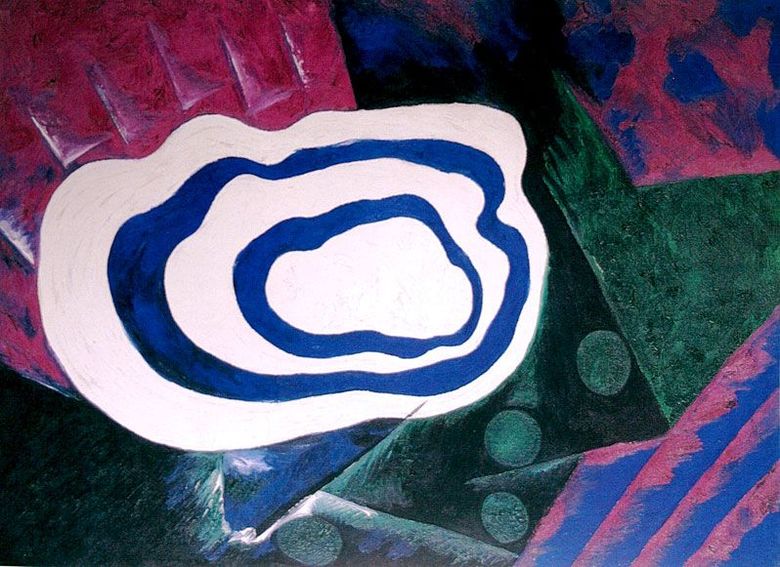
This picture is an exception and, at the same time, innovation. In the works of Goncharova for the first time, almost all Russian avant-garde painting appears an abstract structure in the form of colored concentric rings of irregular shape.
This structure, which has a biological, protein form, is unstable in its outlines, shrinking and expanding in breadth and depth, resembles an unknown material substance, a surge of energy. It is filled, as always with Goncharova, with the breath of life, however, the life of another level – the life of thinking matter.
The rhythm and alternation of blue and white rings of decreasing size with a varying width of a ribbon of dense smooth texture creates its own space flowing inside these forms, streamlined by another space, formed by a pictorial mass of black-green-lilac with a matte texture. The surrounding space becomes permeable, despite the property of a dark matte structure to absorb all light.
Goncharova violates the physics of color and the physics of matter, destroying the unity and material density created by coloring pigments, the introduction of whitewashed painting elements resembling mirror glare. The plane of the whole picturesque field of the picture seems to lose its material boundaries. And the composition is ready to overcome them, becoming, as it were, an illustration of the provision on 4 dimensions: “The picture is sliding, gives a sense of what can be called the 4th dimension – timeless and non-spatial…”.
Material volume – colors, their texture, that is, “complete” – represents “empty”: “full” gives rise to “empty”, volume becomes a category of space. The picture may seem purely abstract. If you think about theosophical knowledge, you can imagine that the central white spot is, as it were, the designation of the tunnel that leads to another world, into an imaginary “emptiness.” This is anotherworldly color. The blue rings are a kind of stepping stone along this tunnel into another world.
The theme of transition to another world is not the first to rise in the works of artists. Similar tunnels were present in the works of other artists-spirits. A striking example is the “Birth of the Human Soul” in 1808 by the German romanticist F. O. Runge.
 Néant – Natalia Goncharova
Néant – Natalia Goncharova Angels, who rush stones on the city by Natalia Goncharova
Angels, who rush stones on the city by Natalia Goncharova Cyclist by Natalia Goncharova
Cyclist by Natalia Goncharova Vase with flowers by Natalia Goncharova
Vase with flowers by Natalia Goncharova Round dance by Natalia Goncharova
Round dance by Natalia Goncharova Portrait of MF Larionov by Natalia Goncharova
Portrait of MF Larionov by Natalia Goncharova Naked black woman by Natalia Goncharova
Naked black woman by Natalia Goncharova Still life with a shoe and a mirror by Natalia Goncharova
Still life with a shoe and a mirror by Natalia Goncharova